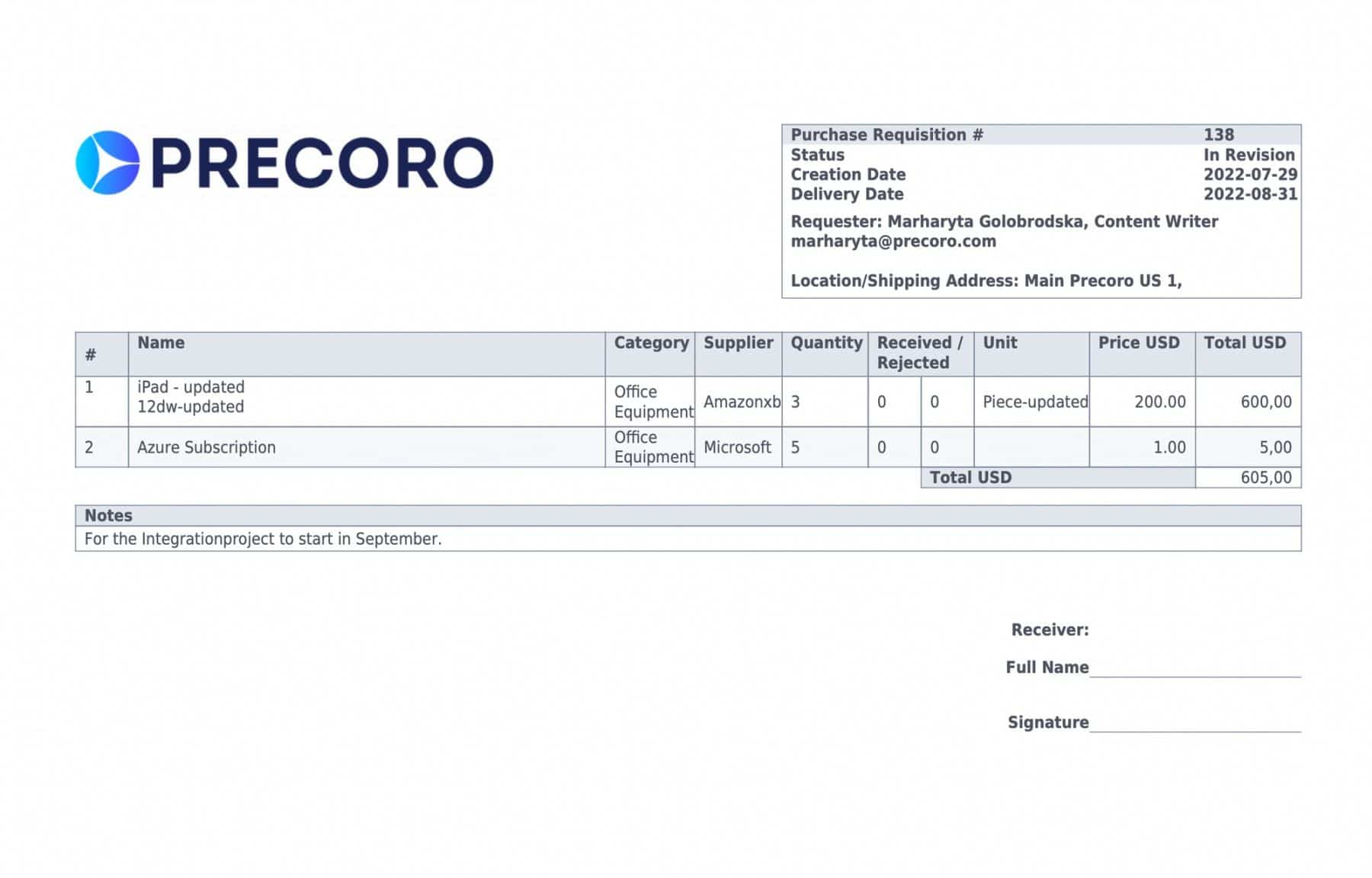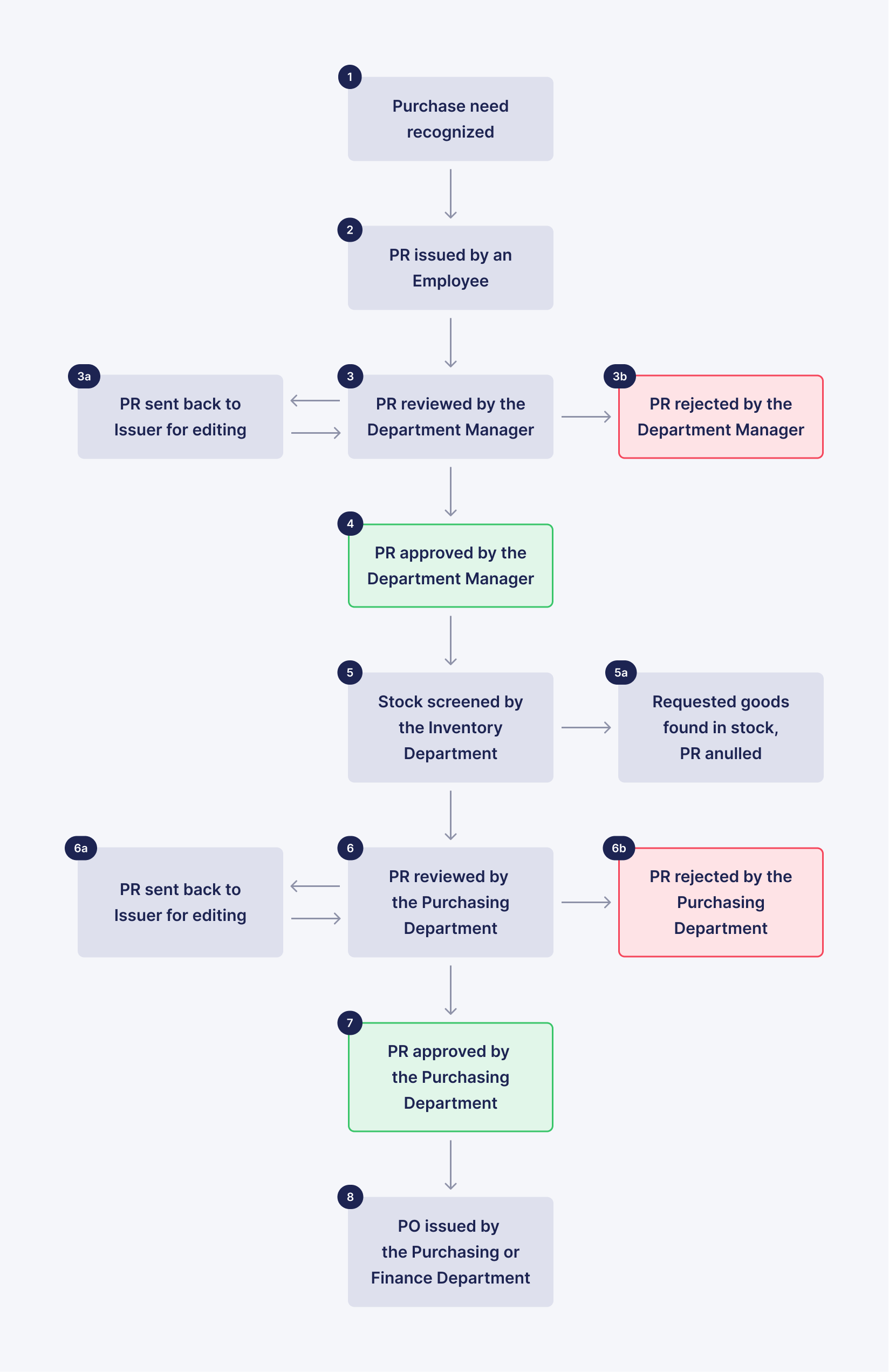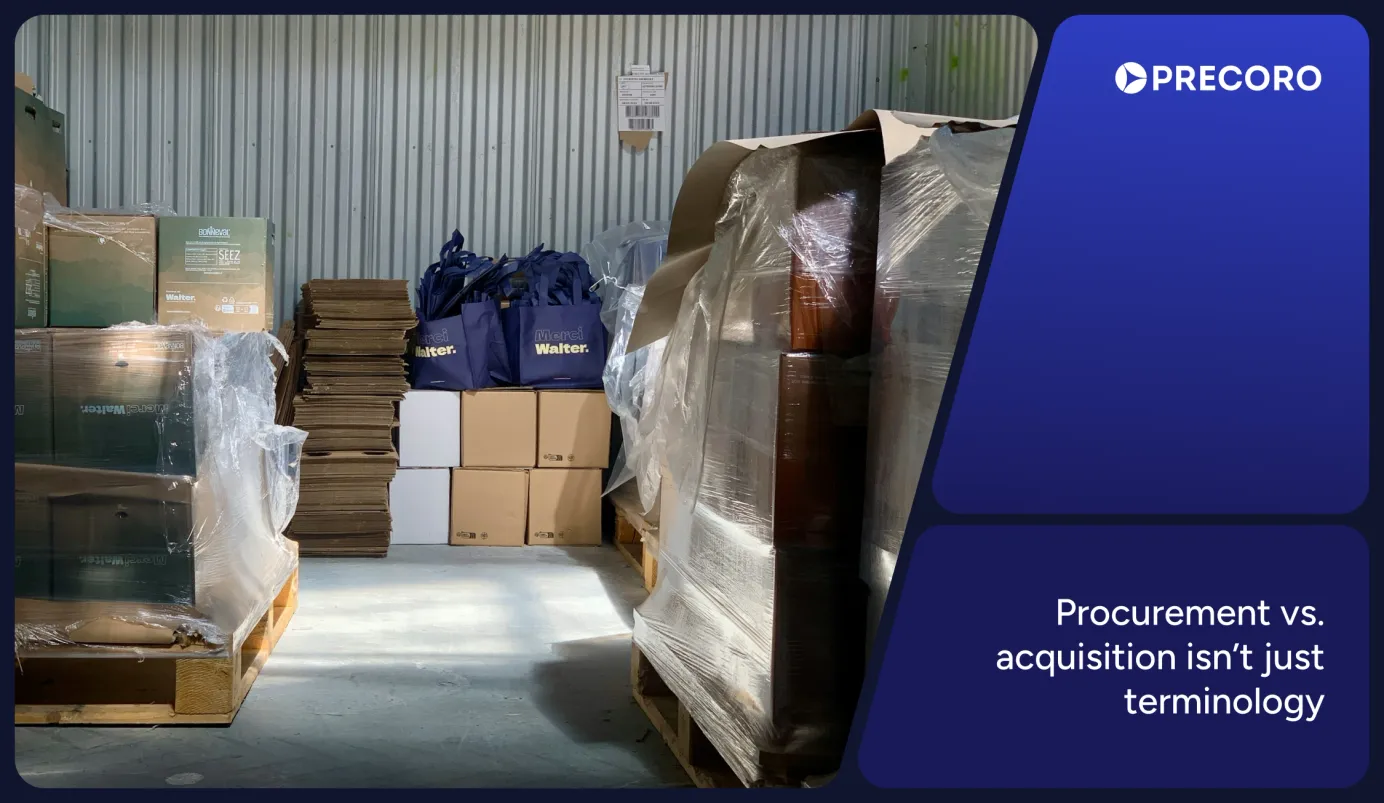
9 min read
Purchase Requisition – What Is It and Does Your Business Need It?
Have you ever felt overwhelmed with numerous employees’ requests to buy things? Purchasing for the business is universal, but what matters the most is how it’s handled. Read on how to utilize Purchase Requisitions to start the procurement process on the right note.
Purchase Requisition Is a First Step of the Procurement Process
When it comes to buying in the name of a company, it’s important to approach the task with great responsibility and critically evaluate the need for spending. Let’s dive deeper and discuss how Purchasing Requisitions can help companies do just that by establishing meaningful communication.
Keep reading to find out:
- What is a purchase requisition
- Purchase requisition vs. purchase order
- Purchase requisition workflow as a part of the procurement process
- Should you use purchase requisitions?
- How to make the most out of purchasing requisition
What Is a Purchase Requisition
Purchase Requisition (PR) is an internal company document issued by an employee to request purchasing of goods or services from the supplier on behalf of the company.
It also leaves an effective audit trail and is used to evaluate purchasing process, budget compliance, and managerial decisions.
PR doesn’t leave the company and isn’t legally binding, but rather ensures an efficient internal approval process and communication.
From recognizing the need for purchase to having products delivered or services provided, there is a number of steps to follow. Purchase Requisition initiates the process.
Who Issues It?
Purchasing Requisition can be issued by any employee who sees the need to buy items, materials or services, relevant to the business.
It’s, of course, a good idea to issue a PR before running out of supplies in stock, as passing the approval process usually takes some time. If there is anything the company needs on a regular basis, it should be requested regularly.
However, PRs are also indispensable in communicating urgent needs or innovative ideas. Let’s say, a travel company is experiencing unusually high interest in Prague city tours for the summer.
An employee would have to order extra walkie-talkies tomorrow to provide for everyone who booked tours in two days. And maybe he’d suggest investing in the booking software to plan better.
What Information Should We Put on Purchase Requisition?
Purchase Requisition forms might differ, but they generally include all the necessary information about requested goods and a requestor:
- Name, department, and contact information of the requestor
- Requisition number
- The date of the request
- The list of items requested
- Description, quantity, and expected price of items
- Legal name(s) and contact information of the suggested supplier(s)
- Requested delivery date
- Reason for purchase
- Any custom information relevant for the requesting company

Purchase Requisition vs. Purchase Order
You’ve most likely heard about the Purchase Order as something related to the Purchase Requisition. These are two key documents of the purchasing process and are often used interchangeably.
They are, however, different – let’s see how.
What is a Purchase Order
A Purchase Order (PO) is a legally binding document issued for external use to regulate transactions between the ordering company and the supplier. It outlines details of an actual purchase that has been approved and is intended to happen.
How is It Different from Purchase Requisition
With a Purchase Requisition, an employee initiates the purchasing process. A Purchase Order is issued when the requisition has passed evaluation and approval. Issuing a PO is the next logical step after approving PR.
Here is a brief overview of the key differences.
| Purchase Requisition | Purchase Order |
|---|---|
| Intention for issue | |
| Requesting a purchase | Placing an order for the confirmed purchase |
| Issuer | |
| Any employee | Employee, responsible for company’s procurement: Head of the department, Purchasing or Finance department professional, CFO |
| Addressee | |
| Head of the department | Vendor or Supplier |
| Communication intention | |
| Internal – communication inside the department and between the company’s departments | External – communication between the buying company and the supplier |
| Legal role | |
| Not legally binding | Legally binding after confirmation by the vendor or supplier |
| Information included | |
| Creation date | |
| Number | |
| Information about a company’s employee making a request | Details of the company placing an order |
| List and description of requested items or services | List and description of items or services, confirmed for purchasing |
| Suggested vendor or supplier | Details of the selected vendor or supplier |
| Expected price | Price as offered by the vendor or supplier |
| Payment terms | |
| Billing and shipping address | |
| Delivery date | |
Purchase Requisition Workflow as a Part of the Procurement Process
The entire process of procurement involves various departments and can be divided into several subsequent stages. Requesting the purchase is one of them.
The requisition process is not to be confused with the full-cycle purchasing process, which is significantly broader. The purchase requisition refers to the set of steps taken to initiate the buying activities: to announce the need for purchase, get approval, and result in issuing a PO.
To ensure a smooth and efficient purchasing experience, companies establish precise internal workflows and communicate them to the team.
Requisition workflows vary based on the size and the specialization of the company, but there are some common milestones to it.
- A need for purchase is recognized.An employee establishes a necessity to buy goods or services. It can be anything, starting from the office supplies purchased regularly, to the goods needed to combat an urgent situation. Or maybe investing in modern machine tools to maximize production output.
- An Employee issues a formal Purchase Request by filling in the purchase requisition form describing what exactly is needed, for which department, and how much it’ll cost. PR is then forwarded to the Department Manager.
- The department manager reviews a PR to decide whether buying would be justified and whether it’s a good fit for the department budget. At this point, Department Manager can offer the PR to other stakeholders for review and discussion, require alterations, or even reject it.
- If a required purchase is seen fit, PR is approved by the Department Manager.
- Inventory Department checks the stock for the required goods. It’s important to keep track of items available in stock to avoid excessive buying. If requested goods are not in stock, PR is forwarded to the Purchasing Department.
The PR is submitted to the Purchasing Department (or other relevant professionals, for example, from the accounting department or finance team) for review.
It’s reviewed to determine whether the purchase is essential to business operations and fits a dedicated budget, if a supplier is legit and if payment terms are realistic. The legitimacy of the Department Manager’s approval is also confirmed at this point.
If any errors are found, PR can be sent back to the requesting department for alterations or rejected.
- If the PR is correct and acceptable, it’s approved.
- A Purchase Order is issued from the Purchase Requisition. This marks the finish of the PR workflow and the start of the PO processing process. There are specialized tools called purchase order software to streamline it

Should You Use Purchase Requisitions?
In smaller companies, PR might be seen as unnecessary – depending on the size and the price of the purchase, company type, and the number of people involved. When it’s a start-up with three employees, and it’s time to buy a printer, issuing a PR would probably be excessive.
But in growing enterprises, standardizing the buying process is crucial for efficiency. The bigger the business, the stronger the need for a detailed purchasing workflow. PR helps facilitate interdepartmental communication, minimize errors and streamline procurement.
Not Using Purchase Requisitions Might Bear Risks
When companies allow employees to put orders directly without having them requested, reviewed, and approved, it leads to maverick spending and a lack of expense control. It also leaves more space for fraud.
With no requisition process in place, there is a higher possibility of spending more than necessary. If your company is on a tight budget or is looking to improve the cash flow, implementing a thorough requisition process might be a good idea.
Benefits of Using Purchasing Requisitions
By utilizing PR as an instrument for regulating purchases, an organization can benefit in different ways.
- There is a clear start to the purchasing process.
- Rights for requesting purchase and placing an order are clear due to established hierarchical approval.
- It’s easier to detect and prevent fraud.
- Streamlined purchasing process leads to cost savings and a shorter processing time accelerates the cash flow.
- Purchase requests are managed centrally, and can be retrieved for control at any time.
- The finance department has more control over the current spending and can plan the budget better for the future.
- Procurement managers can plan purchases in bundles. Issuing fewer POs with more items in each helps leverage the company’s buying power and negotiate better terms with suppliers.
- It’s easier to accumulate information for financial audits. Most audits need to see the evidence of managers’ approvals as a part of the company’s purchasing process.
How to Make the Most Out of Purchasing Requisition
Issuing and managing PRs can be time-consuming and discouraging if dealt with manually.
However, with suitable procurement software, it becomes a part of a daily routine and can be done with minimum effort.
Procurement software helps implement an automated requisition process in which human errors are nearly eliminated. Automation solutions route PRs through the pre-defined approval workflows and accelerate the approval process, minimizing unnecessary delays due to manual confirmations.
To make the most out of PR automation, you could follow these steps.
- Start with mapping out the process – understand it and describe it.
- How does the requisition process look in your company?
- Who can issue a PR?
- How many stages of approval should it pass?
- Who can make a purchase?
- Do you have separate Inventory Management and Purchasing Departments? Or are their roles fulfilled by Finance Department professionals?
- Customize templates. In the software of your choice, create a Purchase Requisition template, define which information you’d like to display, and prefill what’s possible.
- Create databases. Add suppliers with their contact details and assortment into the system to use them repeatedly in the most convenient way. You won’t have to enter and double-check the information every time you create a PR.
- Automize workflows. Define how many steps your approval workflow includes and assign roles to the users involved.
- Create, submit, and review. Start creating and managing PRs in the system and get more done faster and easier.
- Convert Requisitions to Orders. A PO can be created from the approved PR. There really is no need to create a new PO from the scratch – the system will use the information provided in the PR, and prompt you to fill in anything else that might be needed.
- Get reports and analytics. Stay in the loop. With all PRs in one system, it’s easy to access analytics immediately and export reports for internal evaluation or for sharing with the stakeholders and auditors.
Conclusion
Purchasing Requisition is a document that can be issued by any Employee who sees the need for purchase in the name of the Company. When issuing a PR, an Employee should justify the intended purchase and provide all necessary information about it.
While using Purchasing Requisitions might not be required in every company, it’s recommended to establish clear workflows for requesting purchases – especially for growing businesses.
By introducing PRs, companies can improve internal communication, avoid maverick spending and fraud, save money and time, and plan budgets better.
FAQ
PR can usually be issued by any employee who sees a need for the purchase. It can be a purchase to sustain regular operations or something for the suggested innovation.
Not every business needs to implement a PR process. It depends on the company size, employee number, and purchase volume. When the budget is tight or production requires flexibility and the ability to buy fast, it’s a good idea to implement a requisition approval workflow.









